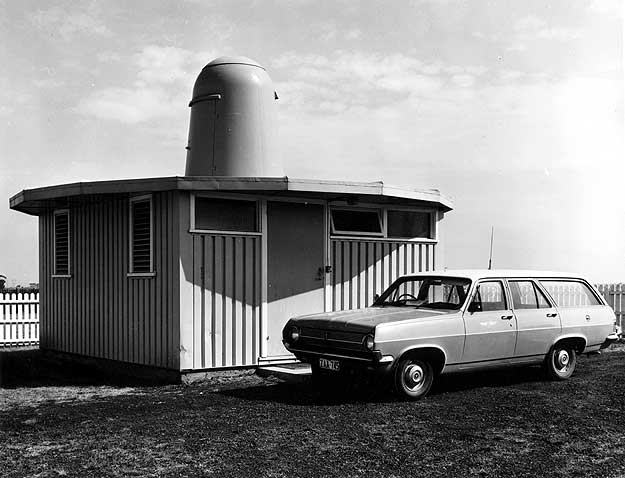
Typical
of the remote location of many navigation aids in Australia is the Mount Hope
VHF Omni-directional Range, or VOR, seen here under a big Australian sky in the
early 1970s. Mount Hope is located on South Australia's Eyre Peninsula at the
eastern end of the Great Australian Bight, which can be seen at left in the photo
above. At this time the Mount Hope VOR was a vital navigation aid for aircraft
flying across the continent to and from Perth: the next on-track aid was the Esperance
VOR, more than 700 miles away.
The photo below shows a simlar, though unidentified, T52 VOR. The hut contained duplicated transmitters and power supply, whilst the fibreglass 'thimble' above contained the actual antenna. These units were supplied by French company AME but the designation 'T52' was internal to DCA.
Note the ubiquitous DCA vehicles, coloured yellow with white roofs - the one below has the DCA 'wings' logo on the door.

In
the late 1950s the VOR was selected to replace the earlier Visual-Aural Range
(VAR) as the main en route
trunk navigation aid. The principal operational advantage of the VOR was that
it offered 360 possible courses, as opposed to the two visual and two aural courses
of the VAR. This made accurate track guidance possible over a much greater number
of routes than had hitherto been possible, with a similar number of beacons.
The first VOR was installed at Sydney's Kingsford Smith Airport in 1960-61. This was followed by another at Darwin in 1961/62. The primary purpose of these two units was to "give guidance to international aircraft operating to these two airports". By the following year ten additional VORs had been ordered at a cost of £135,000, with delivery expected in 1964. A total network of 22 VORs was planned (supplemented by many more simpler and cheaper NDBs).
As at February 2005 there were 92 VOR beacons in Australia and its territories. At that time VORs were scheduled to be phased out by 2010 in favour of the GNSS (Global Navigation Satellite System), however GNSS reliability issues mean that VORs will remain in service for the foreseeable future. The early 'conventional' VORs like the T52 are gradually being replaced with new Doppler units (DVOR).
Read about 'Betsy' the mobile VOR, used to test VOR sites.
(Photos: CAHS collection)
Back to the main Communications & Navigation index
If
this page appears without a menu bar at top and left, click
here